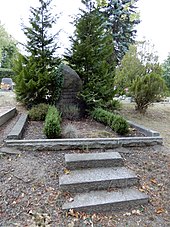Theodor Nolte
Theodor Nolte (born December 3, 1848 in Magdeburg , † February 11, 1919 in Thale ) was a local researcher and local poet with a focus on the region around Thale and the Bodetal in the Harz Mountains .
Life
Theodor Nolte lost his parents at an early age and was orphaned at the age of five . He came to his uncle in Burg (near Magdeburg) , where, despite his inclination to study, he had to learn the bakery trade. Nolte wrote poetry in her spare time. He twice tried to escape the situation, which also included physical violence, by fleeing, but failed. He took part in the Franco-German War in 1870/71. Then he went on a journey and settled in Quedlinburg as a baker. In 1877 he married the youngest daughter of the impoverished manor owner and lord of the castle Olberg . He gave up the bakery trade and moved to Thale around 1880, where he earned his living with a sales stand for Harz souvenirs. In addition, he wrote various writings relating to the region around Thale. His wife and a son died early. Several daughters continued his souvenir trade.
Together with Friedrich Sonntag, the proprietor of the Hotel Roßtrappe , Nolte founded the Thale branch of the Harz Association for History and Antiquity on February 20, 1894 and published articles on resin research in the association's Harz journal . He gained national fame as a chronicler of Thale and the surrounding area. Nevertheless, he died impoverished in Thale in 1919 - scarred by the hunger of the war and the post-war period.
Honors
A street in Thale is named Theodor-Nolte-Straße in his honor . A plaque commemorates him at the transition from Hubertusstrasse to Hubertusinsel . His grave in the cemetery in Thale is a listed building.
Works (selection)
- Harz romance: my Bodethal; poetic memories. Poetry collection, 1887. OCLC 246954918
- The Roßtrappe, the Hexentanzplatz and the Bodetal in terms of landscape and history and their legends. 1892
- The importance of the horse bustard as a pagan sacrificial site of Germanicism 2000 years ago. 1893
- The Edda, the gospel book of ancient Germanicism and its relationship to the mountain theater in Thale.
- The holy sacrificial stone with basin and swastika in the Walpurgishalle on the Hexentanzplatz. 1901.
- The Rosstrappe, the Hexentanzplatz and the Bodetal in terms of landscape and history. 1905.
literature
- Stephan Neef: Harzclub advises: With Nolte against the right. Memorial for Bodetal chroniclers. In: Mitteldeutsche Zeitung , Vol. 11 (2000), No. 155, p. 8.
- Stephan Neef: The fear of an "Ario-Germanic". For the 150th birthday of the local poet Theodor Nolte. In: Mitteldeutsche Zeitung, Edition Quedlinburg, Vol. 9 (1998), No. 281, p. 8.
- Biography in the 11th edition of his work Die Roßtrappe, the Hexentanzplatz and the Bodetal from 1928
Web links
- Theodor Nolte - bodetal.de
- Theodor Nolte - local poet and local researcher (with picture) - harz-tourismus.de
Individual evidence
- ↑ Ute Fuhrmann, Rainer Vogt: A forgotten menhir from a ceramic burial mound at the Honigkopf near Westerhausen . In: Harz-Zeitschrift . Lukas Verlag, 2011, ISBN 978-3-86732-115-0 , pp. 212–230 ( preview in Google Book search).
- ↑ List of the artistically and historically valuable graves according to § 19 - cemetery statute of the city of Thale . In: Thalekurier 11/2018 Official Journal of the City of Thale . October 27, 2018, p. 20 ( bodetal.de [PDF; 12.7 MB ; accessed on February 11, 2019]).
| personal data | |
|---|---|
| SURNAME | Nolte, Theodor |
| BRIEF DESCRIPTION | Thaler local researcher and local poet |
| DATE OF BIRTH | December 3, 1848 |
| PLACE OF BIRTH | Magdeburg |
| DATE OF DEATH | February 11, 1919 |
| Place of death | Thale |
